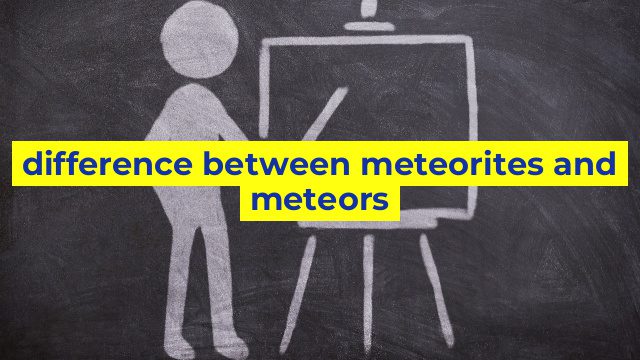Difference Between Meteorites and Meteors: Explained Clearly
When it comes to the celestial objects that fall to the Earth, the terms “meteor” and “meteorite” are often used interchangeably. However, there are critical differences between these two terms that should be understood to avoid any confusion. In this article, we will explain the differences between meteorites and meteors clearly.
What are Meteors?
Meteors are also known as “shooting stars,” which are bright streaks of light that can be seen in the night sky when small bits of space debris enter the Earth’s atmosphere at high speed. These bits of debris are commonly referred to as “meteoroids,” and they usually come from the debris left behind by comets or asteroids. Meteors are typically small, ranging from a few millimeters to several centimeters in size, and they burn up entirely before hitting the ground.
What are Meteorites?
Meteorites, on the other hand, are any fragments of a meteoroid or asteroid that survive the journey through the atmosphere and hit the earth’s surface. They can range in size from tiny dust particles to massive boulders. Meteorites are usually composed of metal, stone, or a combination of both, and they can contain valuable information about the formation and evolution of our solar system.
The Key Differences
The crucial difference between meteorites and meteors is that a meteor is a term used to describe the bright, streaking light seen in the sky when a meteoroid enters the atmosphere, while a meteorite refers to the physical remains that survive the entry and impact of the meteoroid on the Earth’s surface. In other words, a meteor is the phenomenon that can be observed in the sky, while a meteorite is an object that can be studied in a laboratory.
To summarize, meteors are shooting stars that burn up in the atmosphere, while meteorites are pieces of space debris that make it to the ground. While they might seem similar, their differences are vital in understanding the celestial objects that make their way to Earth.
Conclusion
In conclusion, understanding the differences between meteorites and meteors is essential for amateur astronomers and space enthusiasts. The next time you see a bright streak of light in the sky, remember that it is a meteor, and it is unlikely that you will find a physical object on the ground. However, if you do find a strange rock that you think might be a meteorite, be sure to take it to a professional to get it properly authenticated.
Table difference between meteorites and meteors
| Properties | Meteorites | Meteors |
|---|---|---|
| Definition | A meteorite is a solid object that has fallen from space and impacted the surface of the Earth. | A meteor is a space rock that burns up in the Earth’s atmosphere, creating a shooting star. |
| Composition | Meteorites are composed of rock and metal. | Meteors are composed of rock and metal. |
| Size | Meteorites can range in size from a pebble to more than 1 meter across. | Meteors can range in size from a grain of sand to a large boulder. |
| Impact on Earth | Meteorites can have a significant impact on the Earth’s surface, creating craters and causing damage. | Meteors burn up in the Earth’s atmosphere and generally do not impact the surface, although larger ones can cause damage and create sonic booms. |
| Origin | Meteorites come from asteroids or other celestial bodies in our solar system. | Meteors come from asteroids or other celestial bodies in our solar system. |
